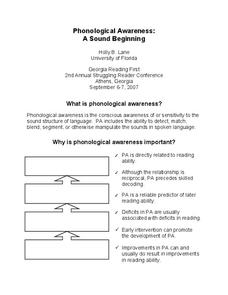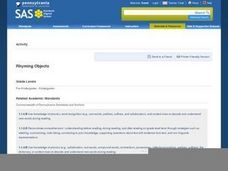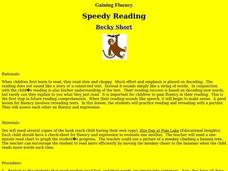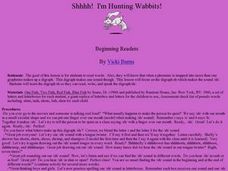University of Florida
Phonological Awareness: A Sound Beginning
Choose from a variety of phonological activities to complement a reading lesson. The guide goes through the basic components of good phonics instruction focusing on sound types, levels of phonological awareness, assessment methods,...
Curated OER
Where are the Mittens?
Help early readers identify rhyming words in nursery rhymes. They will read the nursery rhyme Three Little Kittens Who Lost Their Mittens in order to identify rhyming words. Then they chart the rhyming words they heard in the...
Curated OER
Produce Rhyming Words
Have fun creating rhymes! Your class will read the familiar nursery rhyme Three Little Kittens and list rhyming words. They then use the story as a template to develop their own rhymes.
Curated OER
Letter Hunt
Students search for and find certain letters, blends, or vowel combinations in words, sentences and paragraphs. They investigate how these letters, blends or combinations are used in "every day" writing.
Curated OER
Shhhhhhh! The sheep are sleeping!
Students examine the use of /sh/ in written and spoken words by watching how their mouth moves while making the sound, identifying words, listening to a story, and making words with Elkonin letterboxes. As an assessment, they complete a...
Curated OER
Shaggy Sheba Shakes!
Students study the /sh/ digraph in order to determine that when the letters are together in a word they make one sound. They use letter boxes, letter manipulatives with the sh taped together, and poem, "My Shaggy Dog." Using the...
Curated OER
Phonics: Decoding Words in Connected Text
Introduce your little ones to the wonders of phonemic decoding. They practice along as you sound out simple cvc words in the context of a sentence.
Curated OER
Making More Words With "at"
Learners explore phonetics by identifying words with one specific sound. In this rhyming words lesson, students discuss the sound "at" and the many words that contain the same sound. Learners utilize index cards to participate in a word...
Curated OER
Yellowish Fish
Students engage in an emergent literacy activity in order to obtain the skill of phoneme awareness to become better readers. They practice blending different phonemes in order to eventually form words.
Curated OER
I'm going to chase you
First graders identify the digraphs in written and spoken language. After a brief discussion of the combinations of /c/ and /h/ that comprise the /ch/ digraph, 1st graders practice identifying initial and final placement of the digraph...
Curated OER
Tracking Rubric
In this assessment instructional activity, students read a tracking rubric. The rubric includes the following skills: code knowledge, blending for reading, segmenting for spelling, reading irregular words, and spelling irregular words.
Curated OER
Word Washer Vowels
Here is a perfect activity for all your kinesthetic learners. They practice long and short vowel discrimination as they hang out the paper articles of clothing on a clothes line. They each take turns pulling word clothes out of a pretend...
Curated OER
Phonics lesson for "sh"
First graders identify words with the "sh" pattern. They participate in phonemic awareness, decoding, blending, spelling patterns, and dictation exercises. As the assessment portion of the lesson, they may write a story using words...
Curated OER
Phonics lesson for -ar
First graders identify words associated with the -ar sound. They read sentences and compose a story that include words with the -ar sound. The assessment portion of lesson involves students in spelling words with the
-ar pattern.
Curated OER
Sh Sh Sh: The Baby is Sleeping
Students work with the /sh/ digraph. They read and spell words that contain the phoneme /sh/. Students read Sh!Sh! Stop that Noise. They identify the words containing the phoneme /sh/ while reading the story. Students practice spelling...
Curated OER
Rhyming Objects
Students explore language arts by reading Dr. Seuss stories in class. For this word play lesson, students identify the rhymes in both Dr. Seuss and Nursery Rhyme stories. Students utilize flash cards with rhymes written on them to play a...
Curated OER
Bee a Good Reader
Being able to distinguish between the sounds for short vowel e and long vowel e is an important skill. Young readers are introduced to the /ee/ vowel pattern that makes the long vowel sound. They practice reading and identifying a...
Curated OER
Are We There Yet?
Students continue to study rhyming words. They use words and illustrations to help develop their vocabulary.
Curated OER
Speedy Reading
Students review the cover-up and crosscheck method of reading words before practicing rereading to become more fluent readers. They listen as the teacher reads both with and without fluency to determine which is easier to understand....
Curated OER
Shhhh! I'm Hunting Wabbits!
Students identify the consonant digraph -sh in words and phrases. They practice recognizing the digraph /sh/ through tongue twisters and storytelling. Students read and spell words and pseudowords containing the -sh digraph.
Curated OER
Daily Oral Language Activities: Idioms
Third graders examine the use of idioms. In this vocabulary and reading lesson plan, 3rd graders explore what idioms are and make their own idiom cards to help them understand the use idioms in language.
Curated OER
Sounding Out CVCE Words
First graders explore vowels and consonants by participating in a flash card activity. In this phonetics lesson, 1st graders discuss the difference between short and long vowels and identify them within a story told to them by their...
Curated OER
Word Family Activities and American Symbols
In this word family and American symbols worksheet, students learn about word families and American symbols. They complete an activity in which they create real and nonsense words by combining sounds of the alphabet with 7 different word...
Curated OER
Color Picture/Word Match
Students match colors to the color words that they represent and complete a matching puzzle to go with it. In this colors lesson plan, students put the puzzle together to match up the colors.























